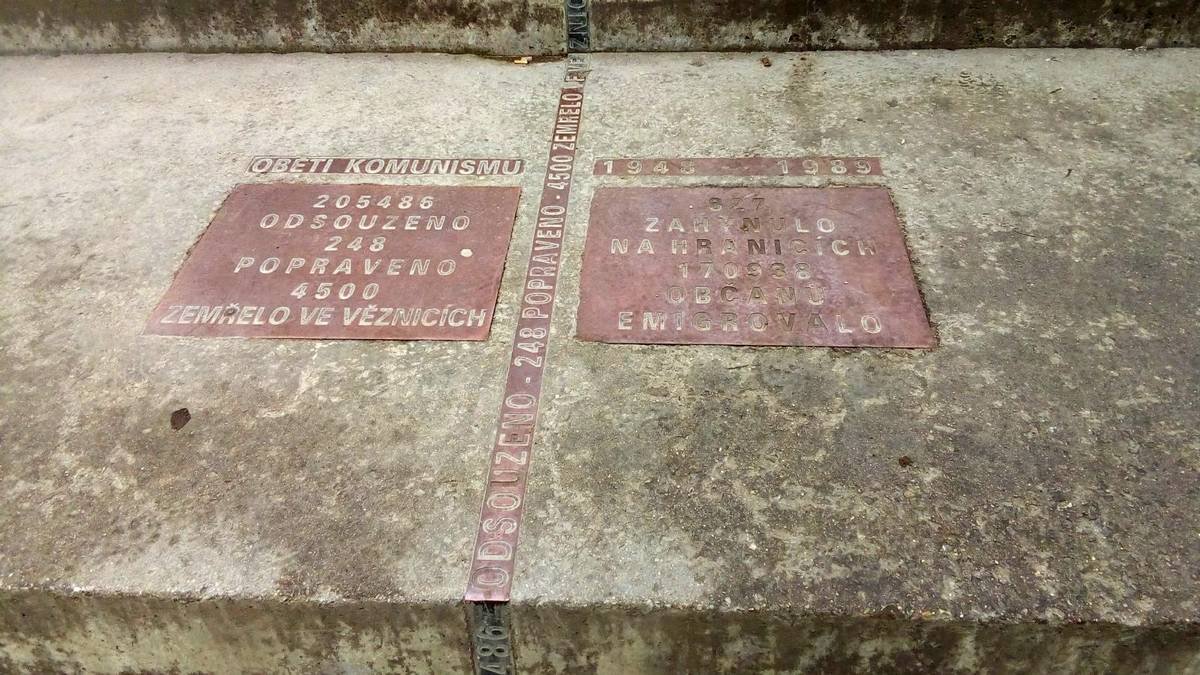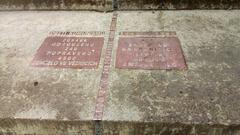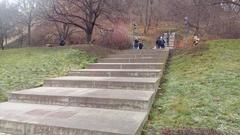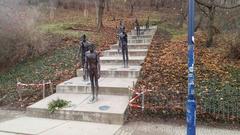
Visiting Alej Obětí Totality in Prague: Hours, Tickets, and Tips
Date: 19/07/2024
Introduction
Alej Obětí Totality, translating to ‘Alley of Victims of Totalitarianism,’ is a solemn and powerful memorial situated in Prague, Czech Republic. This site stands as a tribute to the countless individuals who suffered under the oppressive regimes that have left indelible marks on the history of the Czech Republic. The Czech Republic, formerly part of Czechoslovakia, endured significant hardships during the 20th century, particularly under the Nazi occupation during World War II and the subsequent Communist regime. These periods were marked by severe repression, political purges, and widespread human rights abuses (Prague.eu, Czech Tourism).
Located in the district of Prague 6, Alej Obětí Totality is easily accessible by public transport and offers a profound experience for visitors year-round. The memorial not only serves as a place of remembrance but also as an educational site, providing deeper insights into the impact of totalitarianism on Czech society. The design of the memorial is rich in symbolism, featuring statues and plaques that represent the suffering and resilience of the victims. This guide aims to provide comprehensive information on visiting Alej Obětí Totality, including its historical context, visitor tips, and the significance of the memorial in preserving democratic values and human rights (Institute for the Study of Totalitarian Regimes, Museum of Communism).
Table of Contents
- Introduction
- History of Alej Obětí Totality
- Visitor Information
- Educational Value
- Cultural Significance
- Political and Social Impact
- Photography Tips
- Safety Tips
- Language and Communication
- Additional Resources
- Frequently Asked Questions (FAQ)
- Conclusion
History of Alej Obětí Totality
Origins and Establishment
Alej Obětí Totality is situated in the district of Prague 6, a historically significant area that has witnessed numerous political and social changes over the centuries.
Historical Context
The Czech Republic, formerly part of Czechoslovakia, has experienced a tumultuous history marked by periods of occupation and totalitarian rule. The most notable regimes include the Nazi occupation during World War II and the subsequent Communist regime that lasted from 1948 until the Velvet Revolution in 1989. These periods were characterized by severe repression, political purges, and widespread human rights abuses.
Nazi Occupation (1939-1945)
During World War II, Czechoslovakia was occupied by Nazi Germany. The occupation began in 1939 and led to the establishment of the Protectorate of Bohemia and Moravia. The Nazi regime implemented harsh policies, including the persecution of Jews, political dissidents, and other minority groups. Many were sent to concentration camps, and the resistance movement faced brutal crackdowns. The end of the war in 1945 marked the liberation of Czechoslovakia, but the scars of the occupation remained.
Communist Regime (1948-1989)
Following the war, Czechoslovakia fell under Soviet influence, leading to the establishment of a Communist government in 1948. This period was marked by political repression, censorship, and the suppression of dissent. The Communist regime conducted purges, imprisoning and executing those deemed a threat to the state. The Prague Spring of 1968, a brief period of political liberalization, was crushed by the Warsaw Pact invasion, further entrenching the regime’s control. It wasn’t until the Velvet Revolution of 1989 that Czechoslovakia peacefully transitioned to a democratic government.
Significance of the Memorial
Alej Obětí Totality serves as a powerful reminder of the struggles and sacrifices made by those who resisted totalitarian rule. The memorial is not just a tribute to the victims but also a symbol of resilience and the enduring spirit of the Czech people. It underscores the importance of remembering history to prevent the recurrence of such oppressive regimes.
Visitor Information
Location and Accessibility
Alej Obětí Totality is located in Prague 6, easily accessible by public transport. The nearest metro station is Dejvická, and several tram lines also serve the area.
Visiting Hours and Tickets
- Opening Hours - The memorial is open year-round, and visitors can access it at any time of the day.
- Tickets - There is no entrance fee to visit Alej Obětí Totality, making it accessible to all.
Best Time to Visit
Visiting during spring or autumn provides a pleasant climate for walking and reflection. These seasons offer a serene environment that enhances the experience of the memorial.
Guided Tours
Consider joining a guided tour to gain deeper insights into the history and significance of the memorial. Tours are often available in multiple languages and provide a comprehensive understanding of the site.
Respectful Conduct
As a site of remembrance, visitors are encouraged to maintain a respectful demeanor. Photography is allowed, but it is advisable to avoid disruptive behavior.
Nearby Attractions
Combine your visit with nearby historical sites such as the Prague Castle and the Strahov Monastery, both of which offer further insights into the rich history of Prague.
Special Events and Features
Throughout the year, various commemorative events are held at Alej Obětí Totality. These include ceremonies on significant anniversaries, such as the end of World War II and the Velvet Revolution. Educational programs and guided tours are also organized to educate visitors about the history of totalitarianism in the Czech Republic and the importance of preserving democratic values.
Design and Features
The design of Alej Obětí Totality is both symbolic and evocative. The alley is lined with trees, each representing a victim of totalitarianism. Plaques and inscriptions provide information about the individuals and groups who suffered under these regimes. The serene environment encourages reflection and contemplation, making it a place of both mourning and learning.
Educational Value
Alej Obětí Totality is not only a place of remembrance but also an educational site. It provides visitors with a deeper understanding of the impact of totalitarian regimes on Czech society. The memorial is often visited by school groups and tourists who seek to learn about this dark chapter in Czech history. Informational panels provide historical context and personal stories of the victims, helping visitors comprehend the broader historical events and personal experiences of those who lived through them. This educational aspect ensures that the lessons of the past are not forgotten.
Cultural Significance
The cultural significance of Alej Obětí Totality extends beyond its role as a memorial. It is a symbol of the Czech Republic’s commitment to remembering and honoring the victims of totalitarianism. The site is a testament to the resilience of the Czech people and their determination to preserve their history and identity. The memorial also serves as a place of reflection and contemplation. Visitors often leave flowers, candles, and other tokens of remembrance at the site, creating a space for personal and collective mourning. This act of remembrance is an important part of the Czech cultural tradition, emphasizing the importance of honoring the past while looking towards the future.
Political and Social Impact
Alej Obětí Totality has had a significant impact on Czech society and politics. The memorial serves as a reminder of the importance of democracy, human rights, and the rule of law. It is a powerful symbol of the consequences of totalitarianism and the need to protect democratic values. The site has also been a focal point for political and social events. Commemorations and ceremonies are often held at the memorial, particularly on significant anniversaries such as the end of World War II and the Velvet Revolution. These events serve to reinforce the importance of remembering the past and promoting democratic principles.
Photography Tips
Alej Obětí Totality is a visually striking memorial, making it a compelling subject for photography. Here are some tips to capture the essence of the memorial:
- Lighting - Visit during the golden hours (early morning or late afternoon) for the best natural light. The soft, warm light during these times can enhance the memorial’s features and create dramatic shadows.
- Angles - Experiment with different angles and perspectives to capture the memorial’s unique design. Try shooting from a low angle to emphasize the statues’ height and the slope of the path.
- Details - Focus on the details of the statues and the inscriptions to convey the memorial’s emotional impact. Close-up shots can highlight the craftsmanship and the expressions on the statues’ faces.
- Context - Include the surrounding environment in your photos to provide context. The memorial’s location at the base of Petřín Hill and its proximity to other landmarks can add depth to your images.
Safety Tips
Prague is generally a safe city for tourists, but it’s always wise to take basic precautions:
- Personal Belongings - Keep an eye on your personal belongings, especially in crowded areas. Use a secure bag or backpack to deter pickpockets.
- Weather Preparedness - Check the weather forecast before your visit and dress accordingly. Bring an umbrella or raincoat if rain is expected, and wear comfortable walking shoes.
- Emergency Contacts - Familiarize yourself with local emergency contacts. The general emergency number in the Czech Republic is 112, which can connect you to police, fire, and medical services.
Language and Communication
While Czech is the official language of the Czech Republic, many people in Prague, especially in tourist areas, speak English. Here are a few useful Czech phrases to enhance your visit:
- Hello - Ahoj (informal) / Dobrý den (formal)
- Thank you - Děkuji
- Please - Prosím
- Excuse me - Promiňte
- Do you speak English? - Mluvíte anglicky?
Learning a few basic phrases can go a long way in showing respect for the local culture and making your visit more enjoyable.
Additional Resources
For more information about Alej Obětí Totality and other historical sites in Prague, consider visiting the following websites:
- Prague.eu - The official tourist website of Prague, offering comprehensive information on attractions, events, and practical tips.
- Czech Tourism - The official tourism website of the Czech Republic, providing insights into the country’s history, culture, and travel tips.
- Prague Public Transport - Information on public transportation in Prague, including tram, metro, and bus schedules.
Frequently Asked Questions (FAQ)
What are the visiting hours for Alej Obětí Totality? The memorial is open year-round with no specific visiting hours.
How much do tickets cost for Alej Obětí Totality? There is no entrance fee to visit Alej Obětí Totality, making it accessible to all.
Are guided tours available? Yes, guided tours can be arranged to provide a deeper understanding of the site’s historical context and significance.
Is Alej Obětí Totality accessible for disabled visitors? Yes, the site has pathways and ramps for easy navigation.
What nearby attractions can be visited? Nearby historical sites such as the Prague Castle and the Strahov Monastery offer further insights into the rich history of Prague.
Conclusion
Alej Obětí Totality stands as a testament to the resilience and enduring spirit of the Czech people in the face of oppression. By visiting this poignant memorial, individuals can gain a deeper understanding of the historical impact of totalitarian regimes on Czech society and the importance of remembering these dark chapters to prevent their recurrence in the future. The memorial’s educational and cultural significance extends beyond its role as a site of remembrance; it serves as a powerful reminder of the value of democracy, human rights, and the rule of law (Prague.eu, Czech Tourism).
Visitors are encouraged to explore the serene environment of Alej Obětí Totality, reflect on the sacrifices of the victims, and participate in guided tours for a comprehensive understanding of the site’s historical context. By doing so, they contribute to the collective memory and honor the legacy of those who resisted totalitarian oppression. For more information and resources on the history of totalitarianism in the Czech Republic, consider visiting the official websites of Prague City Tourism and the Institute for the Study of Totalitarian Regimes. Together, we can ensure that the lessons of the past continue to inform and inspire future generations (Institute for the Study of Totalitarian Regimes, Museum of Communism).


























































































































































































